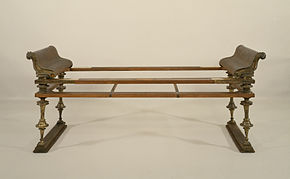Kline
In archeology, a kline ( ancient Greek κλνη ) is a lounger with an upturned head end.
Originally only used as a lounger, the Kline was opened in the 7th / 6th Century BC In Greece also used for food. It quickly developed into the most important piece of furniture for private houses (here as an integral part of Andron, which was establishing itself at the same time ) and public dining places such as B. the Prytaneion .
Execution and use
The main materials used for the Klinen were wood and all metals common in antiquity. Stone clinics are documented in the dining rooms of ancient sanctuaries, in inns and gardens.


While Klinen of the archaic phase are only slightly raised at the head end, several variants of independent headboards were developed in the Greek classical period . In Hellenism this development reached a climax with the Fulcrum-Kline. The new, curved headrests ( Latin fulcra ) are the most important pieces of jewelery in this clinic shape and are often decorated with carvings made of wood, bone or ivory and / or elaborate bronze reliefs. Kastenklinen (plutens in Latin ) became popular in the 1st century . The lying surface was framed by a three-sided vertical or curved frame 40 to 50 cm high. During the Roman imperial era , the sequence of individual clinics in large dining rooms was increasingly replaced by closed systems such as the omega form ( stibadium ) .
The Roman antiquity distinguishes between Kline to sleep in Latin lectus cubicularis and Kline dining Latin lectus triclinaris . Nevertheless - especially in the case of modest households of the time - a multiple function can be assumed.
Furthermore, the Kline could also be used as a death bed. This use is also reflected in the shape of the ancient clinic sarcophagi.
Celtic death beds
The Celts' death beds are not clinics in the scientific sense. In particular, the replica of the bronze death bed from the Hochdorf grave find proved to be very comfortable seating for several people. Remains of another death bed were found in the Grafenbühl grand grave .
See also
literature
- GMA Richter: The Furniture of the Greeks, Etruscans and Romans. 1966
- Helmut Kyrieleis : Thrones and Klinen. 1969
- The new Pauly . Volume 6, 1999, Col. 604 f.
- Stephanus TAM Mols: Wooden furniture in Herculaneum. University of Michigan, 1999
Web links
Individual evidence
- ↑ Gerhart Rodenwaldt : The clinical sarcophagus by S. Lorenzo . 1930
- ^ Kind communication from Thomas Hoppe, curator of the Celtic collection of the Landesmuseum Württemberg .


